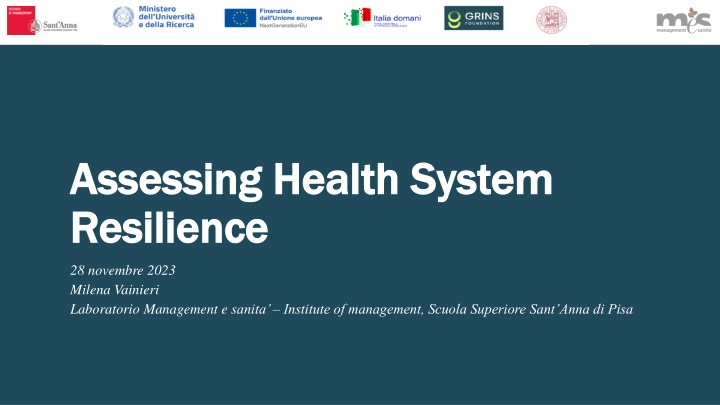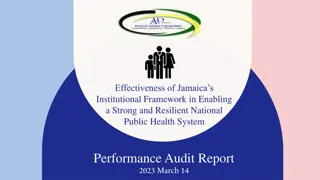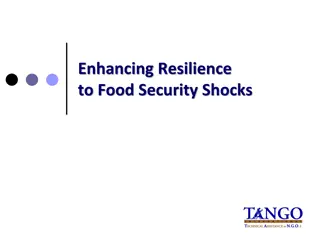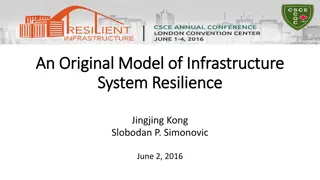Building Measures for Health System Resilience in Europe
The research focuses on analyzing factors influencing health system resilience, with a collection of case studies from European countries. It delves into measuring performance amidst the pandemic and the importance of resilience in health systems. The study explores HSPA initiatives and the European Union's role in endorsing performance metrics related to health status, governance, and accessibility.
Download Presentation

Please find below an Image/Link to download the presentation.
The content on the website is provided AS IS for your information and personal use only. It may not be sold, licensed, or shared on other websites without obtaining consent from the author.If you encounter any issues during the download, it is possible that the publisher has removed the file from their server.
You are allowed to download the files provided on this website for personal or commercial use, subject to the condition that they are used lawfully. All files are the property of their respective owners.
The content on the website is provided AS IS for your information and personal use only. It may not be sold, licensed, or shared on other websites without obtaining consent from the author.
E N D
Presentation Transcript
Assessing Assessing Health System Health System Resilience Resilience 28 novembre 2023 Milena Vainieri Laboratorio Management e sanita Institute of management, Scuola Superiore Sant Anna di Pisa
A brief premise A brief premise
A premise The scope of our analyses is to build up a set of measures to understand the factors influencing health system resilience Large experience in measuring performance in healthcare services (20y) Performance measurement systems in the pandemic era. From dashboards to Health System Performance Assessment (HSPA): E Barbazza, D Ivankovi , K Davtyan, M Poldrugovac, Z Yelgezekova, .The experiences of 33 national COVID-19 dashboard teams during the first year of the pandemic in the World Health Organization European Region: A qualitative study. Digital health 8, 20552076221121154 Vola F, Benedetto V, Vainieri M, Nuti S. (2022) The Italian interregional performance evaluation system. Research in Health Services & Regions Vainieri M., Vola F. (2023) The challenges of measuring performance in pandemic times. Evidence from Italy. In Niccol Persiani, I.E.Vannini, A. Romiti, A. Karasavvoglou, P. Polychronidou Healthcare Systems Challenges in the Era of Covid-19. Springer
What What we step step we are are finalizing finalizing as as first first
What we did? A collection of empirical case studies on resilience in HSPA Presented at the IRSPM conference Submitted to a WHO Bulletin special issue Team: Milena Vainieri, Alessia Caputo & Alessandro Vinci
What we did? A collection of empirical case studies on resilience in HSPA A collection of empirical evidence to understand how European countries have measured resilience in their HSPAs The case study selection process was limited to European Union (EU) for the following reasons: the European Union has played a central role in supporting and endorsing HSPA initiatives since 2014, setting up the Expert Group on HSPA fostering a shared understanding of HSPA approaches by exchanging insights from national experiences; the Country Health Profiles (EU) contain various performance metrics, including health status, health system governance, accessibility, and resilience already a supranational organization providing a guide in including resilience in HSPA even before the COVID-19. the European Commission underscored the significance of resilience in its 2014 report "Communication on effective, accessible, and resilient health systems just after the Ebola outbreak resilience. Thus, there is 2014
What we did? - A collection of empirical case studies on resilience in HSPA We conducted a literature review integrated by the HSPA support program from EU. A total of 845 documents were retrieved with the review of the literature between 2014-2023. Exclusion criteria: no centred on a single national healthcare system or comparison of them. Focused on a single aspect instead of embracing a comprehensive system-wide perspective. Overall we identified 9 countries in EU with HSPA description. We conducted a qualitative analysis to classify the written materials collected (the national HSPAs) based on identified categories of similar patterns. We applied a content analysis to the HSPA collected throughout the literature review process.
What we did? - A collection of empirical case studies on resilience in HSPA No resilience No documents No resilience
What we did? Resilience measured as... Potential unmet needs and lower outcomes. (Italy & Belgium) Potential unmet needs and lower outcomes. (Italy & Belgium) maintain essential health services and quickly resume to optimal performance new invasive cancer cases. The capacity to protect vulnerable groups. (Italy, Belgium, Estonia, Czechia) The capacity to protect vulnerable groups. (Italy, Belgium, Estonia, Czechia) vaccination coverage. incidence rates of vaccine-preventable diseases per 100,000 population, provide mental health services The management s capacity to acquire and use resources (Belgium, Croatia, Ireland, Czechia) The management s capacity to acquire and use resources (Belgium, Croatia, Ireland, Czechia) generic pharmaceutical usage, public health and long-term care expenses, bed occupancy rates average waiting time between test and results, surge capacity investments and reforms should be considered in the context of technological and infrastructure capabilities.
What we did? Resilience measured as... the capacity to have staff prepared (Czechia, Belgium, Ireland, Croatia). the capacity to have staff prepared (Czechia, Belgium, Ireland, Croatia). the number of medical doctors and nurses on beds the well-being of healthcare professionals. psychological state of healthcare workers. Intention to leave and absenteeism questions are used to measure this aspect, the recourse to digital health (Italy, Belgium). the recourse to digital health (Italy, Belgium). digital technologies can be integrated into the patient pathway for routine follow-up appointments or post- surgery rehabilitation, eliminating the need for physical examinations by doctors. utilization of telehealth during the pandemic's absorb phase. strengthening primary health care services (Czechia, Croatia, Italy, Belgium). strengthening primary health care services (Czechia, Croatia, Italy, Belgium). Some countries have incorporated indicators of primary health care into the resilience dimension to highlight the correlation between the capacity to absorb and provide care, especially in response to outbreaks. Indicators related to primary health care often pertain to investments in structural aspects, such as long-term care ( reinforcement of access, such as the number of contacts with general practitioners,
Preliminary conclusions The observed shift in the Italian and Belgian HSPAs highlighted the characteristics of flexibility and adaptability to changing environments. Specifically, in the Italian case, it is more evident how the concept of resilience changes based on the stage of the outbreak. During the pandemic, there is a substantial prevalence of resilience indicators strictly related to tackling the pandemic both in the system delivery (e.g. testing and anti-covid vaccination) and the final goals (e.g. mainly mortality rate for the pandemic) dimensions of the health system. Conversely, in non-pandemic periods, the indicators attributed to the resilience domain predominantly pertain to primary healthcare mainly in the system delivery and intermediary outcome domains. This emphasis aligns with the broader understanding that resilient healthcare systems necessitate robust primary healthcare foundations, ensuring accessibility, equity, and continuity of essential healthcare services even in the face of unprecedented challenges Countries that tend to have lower per capita healthcare expenditure have generally interpreted resilience in terms of investments in infrastructure (illustrated by the cases of Estonia, Croatia, and the Czech Republic). Countries that already had an existing evaluation system before the pandemic have also considered the ability to maintain essential services during critical phases and have assessed the introduction of new services (as observed in Belgium and Italy).
Next steps Next steps
Data collection & analyses oCollect measures of resilience at regional and sub-regional level in Italy oTry to estimate the long term impact of the pandemic on different dimensions of health systems (see for instance the impact on unwarranted variation in elective surgery & the backlogs/waiting times) o Deepen the analysis on the positive deviance related to specific case o For instance investigating the digital revolution & Human resources
Post-doc position Won by Luca Pirrotta Interest in human resources management & communication Master degree in Business communication and HR policies - University of Pisa. Thesis has treated Risk communication during COVID-19 pandemic PhD Health Science Technology and Management (end in December 2023) Period abroad at Harvard T.H. Chan School of Public Health
Grazie! Grazie! Milena Vainieri milena.vainieri@santannapisa.it Responsabile Laboratorio Management e Sanit , Scuola Superiore Sant Anna di Pisa























